 
Ft
Richardson Alaska
In Dec 1960, about two and one half years after I got out of the army at Ft
Sheridan, I enlisted in the U.S. Army a second time
for 3 years and I went to DesMoines Iowa again and
got sworn in there and this time I did not go to
Camp Chaffee, Arkansas but Ft Leonard Wood,
Missouri. I made it down there OK and started
processing in. Date of entry was Dec 8, 1960.
I had been out of service too long to keep the
little rank that I had and on this second
enlistment, went in as a Private E-2.
The first morning there me and a couple people about
like me went to the messhall for breakfast. We'd
waited until the line went down some then queued up
but when we got into the messhall, the shittiest one
I saw in all my time in the army, the food had run
out. The cook said he could fix us some toast but we
said no thanks and went to work call formation.
As soon as we'd formed up here comes this sergeant
and starts yelling at us and telling us all the
things they were going to do to us that day ......
blah, blah. Kind of ticked me off. I didn't think
I'd signed up for this so I shot my hand up (the
only time in six years) and he says "Yeah, what do
YOU want?"
So I ask him if he knew he had a few prior service
guys in the formation. And it got quiet but he rises
to the occasion and hollers out "how many prior
service guys we got in here?" and 2-3 guys raised
their hands, and he said "Fall out here by
me!" And the rest went their way and they
moved us that same day over to an artillery outfit
that was in the old wood-type barracks but fixed up
nice and we never saw the recruits again. That arty
outfit was good people and had a good messhall with
good cooks.
The prior service thing should have been the
sergeant's first item on the day's agenda.
They accepted my Fire Control Instrument Repair
status and soon as I had fired the M-14 Rifle and M2
carbine they started looking for a job for me.
I remember sitting in the personnel office and this
clerk asking me where I wanted to go "this time" and
I said well, I really don't care, I've seen the
eastern U.S. and been to Europe so I suppose the Far
East somewhere, thinking of Japan or Korea. I didn't
really want to go to Korea but would take it if they
had to have me there. The clerk didn't say anything
and I went on my way kind of wondering.
Then, I went for the shots and while sitting there
waiting on my name to be called I was getting my
papers straightened out and there on the bottom of
the form requesting the shots was hand written in
pencil the word "Alaska" and I thought "oh shit,
Alaska is in the Far East Command and when I said
Far East they needed a guy in Alaska and guess who."
I didn't know what to do. Should I accept it or try
to get it changed? Then I figured what the hay, try
it out it's bound to be an adventure ....... and it
was.
I got through the induction process OK and they gave
me a few extra days to get to airfield in
Washington. So I was able to visit home 3-4 days
before I went on to Alaska. Basic training was not given to prior service people.
I took the train to Denver, then bussed from there
to the airfield - can't remember if it was McChord
or SeaTac - I think it was McChord (or maybe even
Ft. Lewis) and Alaska Airlines flew us to Alaska. I
remember the stewardess' wore fur parkas. It was Jan
1961.
Anything you've been told about the place
....... forget it. You'll never be able to
understand until you've been there. Start thinking
in terms of big - small, black - white, love - hate,
tall - short, good - bad, light - dark, joy - pain,
and so on. Contrasts that span an enormous spectrum
and the damnedest place you could ever imagine.
It's gorgeous in a rugged way and things are just
plain different there than here in Continental
United States (that's CONUS in army jargon).
Alaska had just become a state but 3-4 years before
I got there - in 1957. When I got there they were
still using silver dollars. If you went downtown to
go out on the town, you'd come back with a bunch of
silver dollars (change) in your pockets. I saw
several people wearing sidearms right in public, no
problem there.
They got us up there and then no one at Elmendorf airbase could figure
out what to do with me. My orders just said I was to
proceed to the "Carrier Detachment" in Alaska. The
way I understood it, that was what I was supposed to
do and the Carrier Detachment was being set up as an
Ordnance Backup shop at Ft Richardson in Anchorage
for the Alaska Command (all things ordnance in
Alaska).
They couldn't find anything there at Anchorage so
they determined to send me to Ft Wainwright so they
put me on a plane headed that way and next thing I
know, I'm in Fairbanks, Alaska in January and no
winter gear of any kind. The unit they sent me to
fed me and they put me and a couple other guys up in
a big concrete barracks that had the water frozen on
the north side and there was no heat there but the
south side had heat and was occupied.
This sgt got us fixed up with 2 sleeping bags apiece
and a lot of blankets and that was my first night in
Alaska.
They were on the phone all morning next day and
finally Anchorage tells them to send me back down
there right away. So they got me fixed up with a
flight out of Eilson Airbase that evening and it was
dark when we boarded the plane. Now it was winter so
they had much shorter days. It got dark early.
We got on the plane, I couldn't believe it - it was
one of those old WWII C-47's. I had seen them in
movies and stuff but I didn't realize how small they
were. There was me and a master sgt and another guy
I think. He may have been a crew member, don't know.
The thing took off and when we got up in the air,
one of the pilots came over the intercom and said
"light up if you like."
The reason I remember the master sgt is because he
reached for his cigarettes and I got a big whiff of
gasoline about that time and I asked him to not
light up, even though I was a heavy smoker myself.
He was going to do it anyway and the other guy says
"wait, I smell it too" so sgt put'm back, much
appreciated by me, and the crew guy left and got a
flashlight somewhere and started looking out the
windows at the wings and said "yep" and hollered at
the pilots and they somehow got it stopped whatever
it was (smelled like gasoline) or reduced anyway
until it wasn't too bad. Then we made it to
Elmendorff at Anchorage and I got the Hell off that
thing.
I was scared - one of the few times in my life - but
I saw no alarm whatsoever in the plane's crew,
remarkable!
I was beginning to wonder what in the world is going
on here - am I dreaming, or what? Then they
took me to Ft Richardson and I thought for sure I
was dreaming. I had heard that Alaska was all
quansit huts and was prepared for the worst but
there were these big, modern, concrete buildings all
painted in pastel colors - pink, brown, blue, gray,
yellow - I don't know what all. I didn't think it
was pretty, I didn't think it was ugly, I just
thought "What the Hell IS this?"
Man, it was different! When I asked a sgt about it,
he just laughed and said, "Yeah, it's different.
Everybody in the army now calls us "Disney
Land."
They put me in a "repple-depple" on the top floor of
this modern concrete building. Fairly nice .......
while they were trying to find the place I was
supposed to be going to. That took 3-4 days.
While I was there in the repple-depple, 2 things
come to memory:
1) On a Sunday, I asked about a
bowling alley figuring that it wouldn't be too
crowded then so I'd spend a little of the extra
time doing some bowling. Well, I went over there
and it was a small place and only had about 5-6
lanes and when I started bowling guess who walks
in the door and sets up a couple lanes away from
me?
Sgt Harris, our 1st Sgt at Ft Knox, only now he
was a SFC having lost a stripe somewhere. He
barely remembered me but there was no doubting he
was the man. He was friendly enough but just
wasn't overly excited about meeting me so I did my
bowling and we broke off for dinner and I never
saw him again..
I always liked the guy and thought he was a Hell
of a sgt. He may not have wanted to be reminded of
his past performances, I don't know. He could've
been embarrassed by his reduced rank .......
2) Like I said, I was on the end bay of the top
floor and it was largely empty, only about a half
dozen guys there besides me. I was in a top bunk
for some reason. Anyway, here comes
about 5-6 guys with Special Forces patches on
their uniforms and they went to the far end of the
bay maybe 20-30 ft from where I was and they set
up there, all in tight little group off to
themselves. They just had mostly personal gear,
like me but were in camouflaged fatigues, etc.
The next day, I'm just laying there
on my bunk and in through the bay doors comes
their sgt and he had a clipboard in his hands and
went up to them there on their bunks and he threw
the clipboard down on the floor, just kind of
tossed it over to them like you'd maybe toss a
bone to a dog and told them "to get on it" and
they all, eagerly I thought, jumped down on the
floor with the clip board in their midst, their
butts sticking up and heads together, started
working on whatever it was.
Well .....
special forces, clipboard, eager joint effort, etc
and I immediately assumed they had been given a
code to break. I looked at my watch to time them
and the sgt stepped out of the bay to do something
and he came back just a few moments later and
taunting them says "ain't you guys got it yet?!!"
and was 5 minutes by then.
Know how long it
took them to break the code? Would you
believe 7 minutes? Maybe 8 minutes cause I
didn't look at my watch right away when they got
the job!
I was very impressed to say the least. I figured
it'd take them the better part of a day or something
like that. And I never even got to talk to them,
they just stayed in their area and did not offer to
become acquainted or anything like that so I left
them alone thinking that's what they wanted.
I didn't know it yet but the Army has maneuvers
in the winter up there when the ground is frozen
(much of the arctic area turns to mush/marsh in the
summer and is practically unpassable) and apparently
these guys were there to do their thing during the
soon to be held maneuver but I never saw them again,
naturally.
The army finally identified the "Carrier
Detachment" as being an adjunct to the 24th Ordnance
Co. and sent me over there. At any rate, it was
obvious that the 24th would be my destination in any
event, come what may.
There was a little snow on the ground and
it was warm and when I finally got to my barracks
there on Ft Richardson, green grass was showing in
the bare spots on the lawn! On Jan 12th or 13th, not
sure which.
Lineage
And Honors Information
Constituted 18 October 1927 in the Regular Army as
the 24th Ordnance Company
Activated 1 August
1940 at Fort Riley, Kansas
Reorganized and
redesignated 19 July 1943 as the 24th
Ordnance Medium Maintenance Company
Inactivated 9 May
1946 in India
Activated 20
September 1950 at Fort Lewis, Washington
Reorganized and
redesignated 25 January 1953 as the 24th
Ordnance Company
Inactivated 24 June
1955 in Korea
Activated 16
December 1957 in Alaska
Inactivated 1 July
1964 in Alaska
Activated 25 March
1966 at Fort Stewart, Georgia
World War II:
India-Burma
Korean War: UN
Summer-Fall Offensive; Second Korean
Winter; Korea, Summer-Fall 1952; Third
Korean Winter; Korea, Summer 1953
Southwest Asia: Defense of
Saudi Arabia; Liberation and Defense of
Kuwait; Cease-Fire
Decorations:
Meritorious Unit Commendation (Army) for
SOUTHWEST ASIA 1990-1991
I arrived there early Jan 1961 and like I said,
there was green grass on the front lawn. It was one
of the brand new buildings and pretty nice. When
they delivered me there, it was to the back door in
the parking lot area. And there in the parking lot,
2 items that were a portent of what was to come.
Racks of numbered Skis and Posts for electric
outlets so you could plug in engine heaters. I
didn't have a car but the supply room issued me a
pair of cross-country skis right with my bedding.
I entered the rear door by the messhall and reported
to the 24th Ordnance Company's orderly room. They were
not impressed by my orders but signed me in and sent me to the west bay
on 1st floor of the building and there were a few
"Carrier Detachment" guys there when I got there.
But there never was a "Carrier Detachment" there that I
know of. They later rolled us over into the 24th
Ordnance and I served the 2 years with them. This is a
picture of me sitting at the 1st sgt's desk on C.Q.
duty. The picture was taken about 1 1/2 years after I
got there. Beware the picture as it was taken in a
mirror, with a timing mechanism. You can see part of the
Ordnance Pot on the front of desk. Note also my command
patch as it is on my right shoulder due to the reversion
of the image in the mirror.
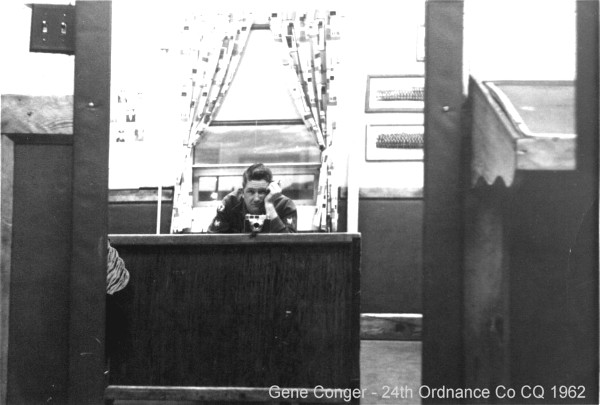 Just to the right of
the mirror is a "sign-out board" where soldiers sign
out of the company to go on pass, leave and such.
The mirror is probably 3/4 length and is
for the personnel to check their appearance before
they leave. Just to the right of
the mirror is a "sign-out board" where soldiers sign
out of the company to go on pass, leave and such.
The mirror is probably 3/4 length and is
for the personnel to check their appearance before
they leave.
There was an anti-aircraft missile company on the 2nd
floor and at that time, 1961, the missiles were hot
stuff and those guys just kind of hung together and
didn't mingle with us, probably because of secrecy
rules.
There was someone else there on the top floor but can't
remember who.
I wasn't there long and they formed a Battalion from the
diverse elements and made a slot for a Lt. Colonel and I
suspect that was the purpose of all the baloney - just a
way to open up another slot and get another field-grade
officer on the payroll. They had more field grades per
private there in Alaska than anywhere else in the Army,
I swear.
I got settled in and was taken to the shop and it was
very modern and really nice. The best place I ever
worked while I was in the army. Now, just the work area,
building and so forth. In this picture is a 1st Lt, our
shop officer, I've forgotten his name and he was
Japanese so I guess I wasn't that far from the Far
Eastern Command after all, eh?
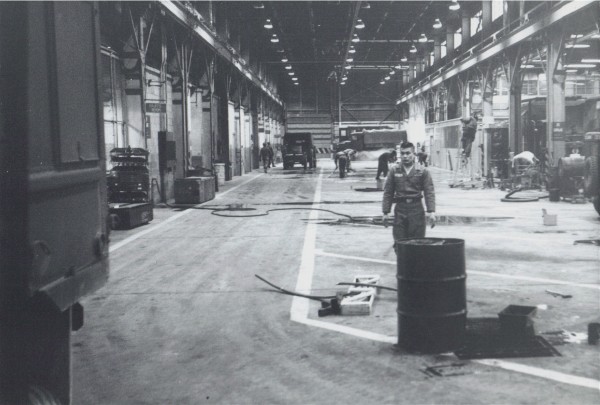
The 24th Ordnance Co supported 1 brigade of infantry,
which was supported by 1 troop of cavalry and 3
batteries of artillery - only a few M41 tanks (one troop) and 8
guns plus 4 ea twin forties!
The artillery was 1 battery of 105 S.P. Guns just
like we had in Germany and one battery (the only one
left in the army) of ancient 75mm Pack Howitzers! They
called'm "pack howitzers" because you could break them
down and pack them on mules (but they used helicopters a
lot). They also had 1 battery of Tracked
"Twin-Forty" 40mm AAA guns.
About 4-5 companies, total. Plus one brigade (?) of infantry.
In Germany, Dancy and I supported two battalions of tanks, (8 troops, or
tank companies) one battalion (4 batteries) of artillery, and one
battalion of mixed anti-aircraft (another 4 batteries).
Overall, about
16 companies in Germany. Plus one battalion of infantry and one big battalion of engineers.
There was an Instrument man there at the 24th's shop
(only one guy) who was a likeable fellow and seemed
competent. When I talked to him to find out what the
situation was, he said there was work for about 1 man, plus. Too much for one guy but not enough for 2 men and
he named the outfits (above) that we supported. I didn't
worry too much about it then, that came later.
It started turning real cold and pretty soon the snow was
crunching under your feet when you walked in it. About
that time one day down at the shop the Platoon Sgt said
he had to go to town, Anchorage, to the bank and wanted
to know if I'd like to go along for the ride and get a
look at the place, so I did.
More introduction to Alaska. We got in the car and he
takes off about like you would on dry ground and then he
comes to the first stop sign steps right down on the
brakes and I just straightened out like a board and the
car came to a halt just where it was supposed to. Next
stop, same thing. He must have noticed my discomfort
because he said, "Oh, we don't pay much attention to the
snow up here. It's so cold, it generally freezes dry and
if it's dry snow, you have a lot better traction and can
accelerate and brake on it a lot better."
Well, he was pretty close to right but I was almost a
nervous wreck by the time we got back. There was better
traction there in the winter than down here, in Iowa
yes, but ..........
He struck me as being a good sgt but I never really saw
him at things Ordnance because he rotated out about the
same time as the Instrument Man did so don't know if he
was competent that way.
I never started taking pictures in Alaska until probably
about fall of 1961.
Then in late Jan 1961 it was maneuver time and
there was debate on whether I should go along with the
company. I had not gotten the "Cold Weather
Indoctrination" that was mandatory for all new people
but they decided I'd go and could do that "on the job"
more or less.
So up Alaska's highway I go to the maneuver area there
around Mt McKinley somewhere, with the rest of the
company. The fire control guy I replaced didn't go and
rotated out of Alaska.
I can't remember much of what went on but we sat in our
5-man tent the whole time. There was 4 of us sleeping on
folding wood/canvas cots in the tent which had a liner
and a gasoline "Yukon" stove and was fairly comfortable.
There were 3 guys and myself in the tent.
I do remember just messing around in the edge of our
company area and I got to see a porcupine and a
ptarmigan and that was about it. That was all the
wildlife I remember seeing that first winter. I think we
may have been in higher elevations than most game. We
were up in the Mt McKinley park area.
One day, we had gone to the mess hall for a meal and
then we came back to the tent in the evening there and
somebody, for some reason, untied the rubber gas line
from the side of the tent where it was kept away from
the stove. Possibly they had trouble when they put a
full 5gal jerry can of gas on the tripod outside the
tent and it was tied too high up and gas wouldn't flow
so they took the line down off side of tent and it just
lay there and somehow got up against the stove and I
think that by the time they got it away from the stove
it was damaged and leaking?
Anyway, you could not smell gasoline. I never did smell
it, maybe just a hint of it every once in a while.
Somebody wanted to heat some water and I guess you did
that by positioning the water can by the stove and
opening the lid so the heating water could expand (some
of the guys had been burned when the water got hot and
they opened the lid the water blasted out and hit them.
The lid was lever-locked, either open or closed, no
in-between). Anyway they opened the lid and had the can
right by the stove and seeing the line drooping in the
area draped it over the water can, using the can to keep
the tube away from the stove I reckon. Some of the
gasoline had to have drained down the side of the line,
hit the can and dripped into it.
I had brought a canteen cup of coffee with me from the
messhall and it had cooled so I set it on the stove to
warm up and forgot it while I was doing something else
and the coffee nearly all evaporated and crusted up in
the cup in a big mess so I took the cup to the water can
and filled it maybe 2/3 way with water and set it back
on stove so I could clean it up.
Well, I'm setting on my cot writing a letter home and so
help me "whooof" it went and broke into flame .....THE
WATER WAS BURNING!! So Valdez, who was also
writing home and had a clipboard, smartly laid the
clipboard on the canteen cup and it quit burning so he
retracted it and while we were setting there in shock at
this wonderment it whooomphed again and I said better
get that thing out of here.
I was right by the zipped up door out of reach of the
cup and the other kid got it and headed for the door.
Poor kid, he got almost to the door which I was trying
to get open and he stumbled and the burning water
slopped on his hand and the poor guy dropped it and when
it hit the floor all Hell broke loose and the place just
went WHOOMPHF and I was out the door, Valdez was right
behind me and the other poor guy was carrying the
burning liner of the tent on his back when he came out
right behind us - all in a matter of seconds.
Never seen anything like it! Just right now! The
whole area by the door was burning.
The 4th guy in the back of the tent couldn't get out so
tried to go under the tent's side but he couldn't get it
raised up so he started for the door again and realized
he couldn't get through so went back to the tent's side
again and that time got it up high enough he could get
out that way.
Valdez and I were in the front trying to get the liner
off the 3rd guy and people start running to help. By the
time they got a fire extinguisher there, the tent was on
the ground. I can't remember the 3rd person's name but
he was Mexican and I think he was married - was pretty
good guy and I can picture his face in my mind to this
day.
They got the burned guy out of there and he was sent on
down to the burn center in Texas and that's the last I
saw of him. The other 3 of us got hardly a scratch but
all of our gear was gone, parkas and all. We started
cleaning up the area and got everything picked up and
started retrieving the tent pegs that were driven into
the frozen ground and we couldn't get them out of the
ground!! They were aluminum type pegs and we broke 1 of
them off trying to get them out and bent up the others
and left about half of them frozen in the ground.
How the guy got the one peg out seems a miracle yet to
this day.
All because of some burning water ........?
Apparently, the gasoline had been dripping on the floor
for some time and we never noticed it in that cold
weather. It was running between 25 and 35 degrees below
0 during the maneuver and in that weather we just never
detected the odor of the gasoline. Not in any strength,
anyway.
We had no tent but were allowed to sleep in an ordnance
van as best we good. One guy had no cap and I had only a
field jacket some one loaned me and that was about it.
Luckily the maneuver was over and we would be leaving in
the next day or two.
Now, there were two units still in the area, our 24th
Ordnance and a medical unit I think it was. Anyway, the
weather forecast wasn't good so our company decided to
stay put for the night but the medical unit figured
they'd make a run for it and get through the pass and
started out on the exit road before the weather got
there.
They were wrong. They started out of the area and their
convoy was effectively cut in half going through the
pass area and half of them wound up on the road
overnight. Those poor Engineers had been working
non-stop to keep the pass open and when the wind got
going real good they just couldn't keep it open and
their equipment got bogged down and a few of the medical
vehicles got stuck right in the middle of the pass,
cutting the convoy in half, some going on and the others
staying put.
The next day the wind died down, the engineers regained
control of the road and we got out of there and back to
post.
Alaska can be a wonderful place but if you don't pay
attention, it can be deadly.
Just oddity onto oddity ...... when we got back to post,
they had an investigation because none of the material
from the fire was reclaimed as it was considered damaged
and untrustworthy by our officers. Our weapons were even
involved in that deal and they were thrown onto the
burned remains and gasoline poured on and the whole pile
of stuff was burned, mess kits, clothes, all of it.
This was done at the order of 1st Lt Steed who, as far
as I was concerned, was a fairly decent officer. But
somebody had it in for somebody or maybe they were just
under worked and needed something to do. I had to report
to some officer in some office on main post about 3
times and be questioned over the deal.
There may have been a reason for my being questioned
......... just as crazy as the fire but real, none the
less ......... why were the khaki summer uniforms on the
salvage list?
Having just arrived from CONUS in Jan, I had sent all my
clothing that was wrinkled from being squeezed into the
duffel bag to the quartermaster laundry so that it would
look nice hanging in my wall locker and I could pass
inspections, etc.
Well, when I had to go on the maneuvers I took off for
the boondocks and when the laundry was done, it was
picked up and taken to our barracks back at Ft
Richardson. We were in the boonies on maneuvers and I
just left the bundle back at the barracks. Then I
started running out of underclothes and socks so when
the company made a run to the barracks one time they ask
if anybody needed anything from back there and I told
them to send my laundry bundle up and they did.
Well, it had those khaki uniforms in the bundle, right?
So, there I was in middle of winter on maneuvers with
summer khaki uniforms and they were damaged in the fire
and I put them on the list for replacement.
Now if I were the investigating officer and somebody
came to me with a cock and bull story like that, I
probably wouldn't believe him either, so I never really
held the repeated interrogations against them and must
have convinced them it wasn't a hoax to just get more
clothes but it took a couple extra trips over there to
do it.
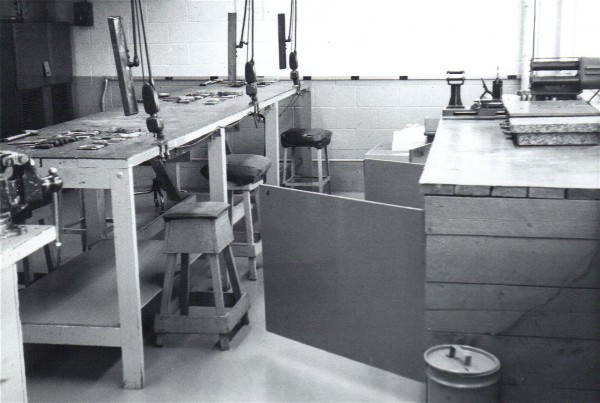 We got the maneuvers over, got back to Ft
Richardson, and got settled down finally. And I
overhauled the shop area somewhat. They had a table in
it that was kind of shaky ..... pretty
touchy and you couldn't bump it or anything else or it
would throw your leveling off on the surface plates
while you were working on instruments so I got some 2x
lumber and made a work bench that was solid and didn't
wobble around when you were trying to do some work on
it. This picture was taken when we were readying for an
inspection and the solid bench I made is on the right. We got the maneuvers over, got back to Ft
Richardson, and got settled down finally. And I
overhauled the shop area somewhat. They had a table in
it that was kind of shaky ..... pretty
touchy and you couldn't bump it or anything else or it
would throw your leveling off on the surface plates
while you were working on instruments so I got some 2x
lumber and made a work bench that was solid and didn't
wobble around when you were trying to do some work on
it. This picture was taken when we were readying for an
inspection and the solid bench I made is on the right.
Then we personnel were moved from the barracks bay in
the west end to the bay in the east end and life kind of
settled down with summer approaching and what not. I was
running the Instruments Section by myself - the only one
there at the time, I'm not even sure I was a PFC then.
But I ran the section ever since the other guy had left.
Our shop had windows of tinted
optical class which was very nice as you could make
adjustments to the optical instruments looking right
out into a good field of view and you didn't have to
worry about aberrations in the glass causing you to
make errors in the adjustments. We had a couple
target  signs hanging on a fence out there - nothing
fancy but something specific we could zero on. signs hanging on a fence out there - nothing
fancy but something specific we could zero on.
Interesting thing that. In the summer the sun shines
most of the day, even in Anchorage area. In the peak of
summer we'd have to draw the blinds at night to sleep.
It didn't stay light in night time at our latitude but
it never really got dark either.
We had a lot of ground tremors while I was there. One
time we had just got off work for the day and marched to
the barracks as we usually did and just when we fell out
of formation and went into the barracks a pretty good
little tremor hit, very noticeable. We were in the bunk bay
hanging up hats etc and this kid yells out, "Hey, come
here quick!" and he is standing by the window at end of
barracks looking out at street so we all run over there
to look and here is this guy with his car in the middle
of the street and he is walking 'round it looking up
under the wheel well, then to the next one, on around
the car and getting back to the driver's door, stands
there a moment, shakes his head and gets back into his
car and drives off!
We are laughing like the devil knowing there was a
tremor but he in his car couldn't figure out what had
happened. He probably thought his car was coming apart.
I pulled KP there several times - until I got my rank
back. They had a nice mess hall but the food wasn't that
great for some reason. It was real food and there seemed
to be enough of it but it just wasn't good. About all I
liked was the spaghetti, naturally, and the SOS and the
Yankee Pot Roast.
Somewhere in the summer months we got some more Fire
Control Instrument people. Three of them, to be exact.
So that made a total of 4 men and not even work for 2.
We had a hard time staying occupied but I just stuck to
running it and trying to improve the place and make sure
the new guys got to do most of the work so they could
learn their jobs. Here are two of them, Oliver Dettman
and William Forst both of whom turned out to be
competent people.
Dettmann, the taller of the two, was a very precise
worker, a genuine perfectionist and I appreciated we had
at least one guy besides myself who could do the really
delicate and sensitive jobs. I believe he was working on
the artillery gun-sight right there on the table, a M1A1
Sight Mount which was used on the "Pack Artillery." The
Model no. should indicate it's longevity in the army. M1
had to be an early model number, eh? It held the
Panoramic Gun-sight which could be the instrument at the
far end of the table. The older stuff was made of brass,
was heavy but generally worked very smoothly.
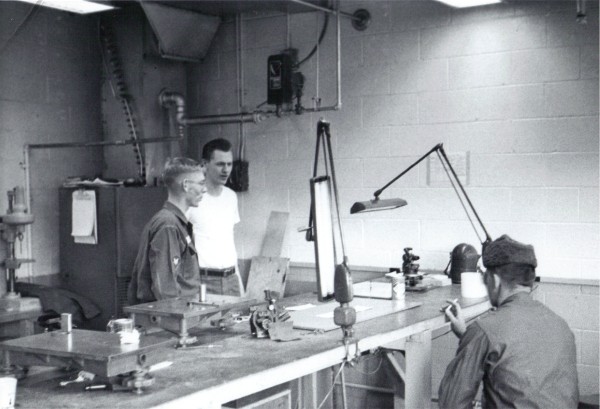
The sights seen and discussed here were the arty
sights for the 75mm Pack Howitzers.
The third person there is an artillery mechanic named
Boisen, a genuine hero.
Boisen was on his way to Alaska
via air and the passenger plane he was on started
having trouble over the ocean and was losing
altitude and wouldn't make shore. The pilots called
the Coast Guard for help and then they and the C.G.
figured about where the plane would land in the
ocean and the C.G. said they could have a ship at
so-so point and that is what they did. The pilots
got the plane there and the Coast Guard was where
they were supposed to be so they got the plane down
on the water OK and the crew opened the door and
Boisen was right by the door so one of the first
ones out but he wouldn't leave the plane and then
helped get the rest of people out, including
dependents, and the Coast Guard got them onto the
ship and no one got hurt. Can you imagine that?
For
his efforts Boisen was awarded a Presidential
Commendation, a highly valued award in the military.
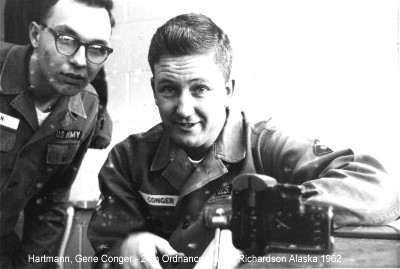 To the left is the third man into
the section (and me) looking at my camera which was
taking the picture at the time, His name was
Hartmann. He said he had never seen a timer work so
I was showing him that feature of the camera. To the left is the third man into
the section (and me) looking at my camera which was
taking the picture at the time, His name was
Hartmann. He said he had never seen a timer work so
I was showing him that feature of the camera.
Then I had an opportunity to go to NCO School there
and I almost didn't go because I was afraid that maybe
on a small post like that with minimal resources, they
could not do a creditable job training people.
Boy, we got a workout in that place. I doubt we averaged
4-5 hrs sleep a night. Lots of study on map reading,
leadership, and so forth. One time one of the guys was having problems getting his shoes shined. He said
there was oil in them and he couldn't get it done. It
became an item which drew a lot of attention and finally
one day the top Sgt waited until the guy had left the
area then took one of his boots home with him and
brought it back the next day and held the boot up at
work formation in the morning and showed everybody and
it was shining like a mirror and he said, "If the other
boot does not look like this by retreat this PM, this
man is out of here. The poor guy tried but couldn't do
it and was sent back to his unit. We started the class
with about 33-35 guys and about 30 or so graduated (Guys
leave the class for different reasons, I only remember
one guy being told to leave).
Heh, they were teaching us how to teach. We had to know
how to train people. So, we all had to give a class on
some subject pertaining to soldiering and I got stuck
with map reading. Anyway, in their instructions they had
told us that when you start your students' class, you
have to get and hold their attention and you should
either tell a short joke or ask some question pertinent
to the material the class was to be given.
Well, I got up in front of the class and I'm introverted
as Hell anyway and I was scared to death to speak in
front of a bunch of people and I did not think I could
tell a joke so I just ask a question. Now maps and
reading them is a complex subject and there are about as
many kinds of maps as there is Christmas candy. So I ask
the class if any one there knew what "shaded relief" was
and some joker immediately jumps up and says "I do, I do
.... it's a guy taking a shit under a shade tree." And
the class just roared so they got me through the thing,
at least (Relief maps are shaded to show geological
features in the terrain).
We had done all the class room stuff and it was time to
try some of the stuff in the boonies so we formed up for
a night exercise with all our combat gear on and took
off, the mission being to knock out a radar tower. When
they put me in charge, we were ambushed and I correctly
laid down base of fire and sent
flanking fire team, etc - did every
thing right ...... EXCEPT, I wasn't supposed to knock
the gun out. My mission was the tower. I was supposed to
slide off from the ambush best I could and go for the
tower. I felt kind of low about that but they didn't
make a big deal out of it and I passed the course but I
never forgot it either ...... keep your eye on the goal!
I'm more than happy to report that my fears were
completely unfounded as to the capabilities of the
school and that, as a matter of fact, the objects of my
fears were actually assets and they did a good job and I
learned a lot there. I finished that up and went back to
the company and down to the shop. That's me in the top
row, 3rd from the left. Looks like I was a PFC when I
went to the school.
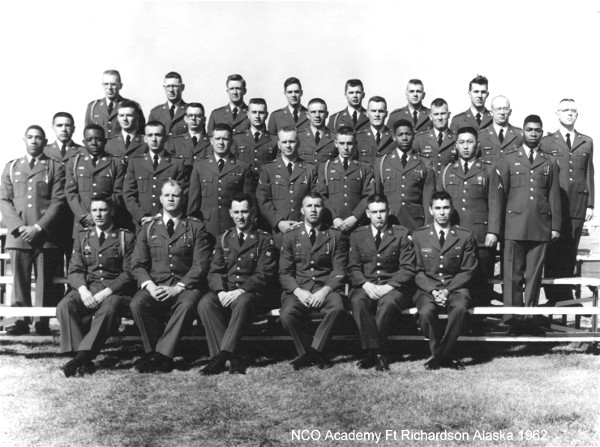

Then we got the 5th Instruments guy. He was George
Forbes, a Sp-5 who they sent there to fill the slot
because of the reorganization from a company to a
battalion. Honest to God. Before it was done, there one
time we had 7 guys in the 1-man section!!
For some reason, I do not have a picture of George.
George was a good instrument man and had, I believe,
taught at an instrument school somewhere - don't
remember whether it was APG or not.
About this time, they had their annual "missile shoot"
there at Site Summit. There were about 6 sites in Alaska
that had the Nike ground to air missiles. There were 2-3
sites up by Fairbanks and 3 sites by Anchorage. Every
year each site (battery) fired one missile from Site
Summit.
And we would be watching.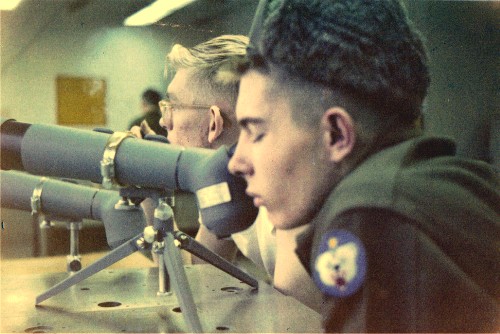
Here are Forst and Bonsack (another arty mechanic)
watching the event. I generally just used a pair of
7x50 pair of binoculars and that way I could watch
the missiles in flight. They would go up to maybe
15,000 ft, lay over on their sides and their main
engine would kick in and they'd take off down range
and explode while still in view from where we were.
During the week of the exercise they fired one
missile each day.
This is site summit. I told the guys I could
photograph it and they didn't think so. I got my
"collimation" telescope out, set eyepiece of one of
the 20x scopes to exactly "0" diopters and just put
the camera lens flush to the eyepiece and viola
.....
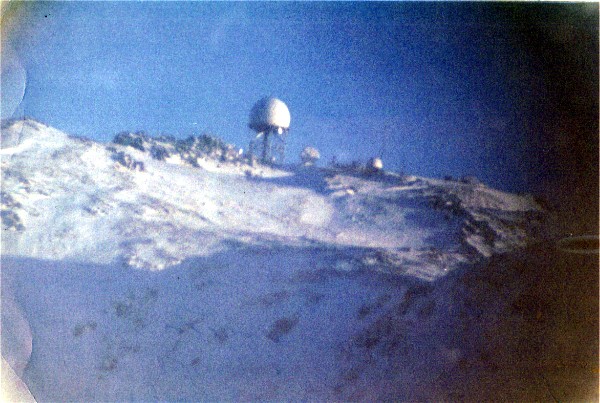
I knew the thing was secret,
probably, and almost never sent the film to be
developed because I was afraid I'd be arrested or
something then decided well, what the heck ......
and took it to the PX anyway and they processed it
and no one said anything. Kind of surprised me.
'Course it's not that good anyway but where there is
smoke ..........
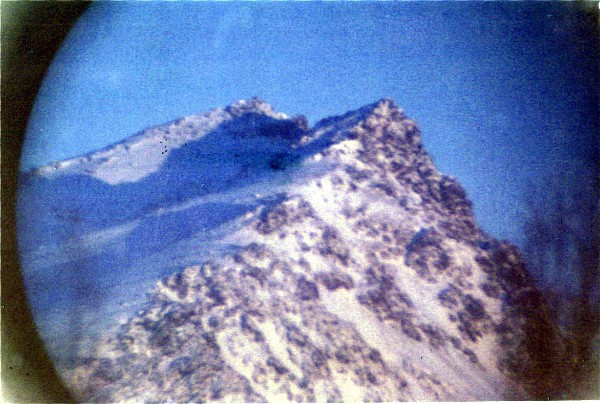 So then I did this one on a closer peak
..........
So then I did this one on a closer peak
..........
At Ft Richardson they had a curious view of the
"Specialist" ranks the army had just created. It
was confusing to me then and is even more so
today. When I was in Germany, the army embarked
on a ranking system that would help them keep
highly trained people. The weapons and tactics
had advanced to the point this was necessary.
When they first started, they had specialist
ranked from E-4/SP3 thru E-6/SP1, the higher the
SP number, the lower the rank.
BUT, by doing so, they shot themselves in the
foot because they wanted to have more pay grades
but couldn't insert them because of the way they
were numbered. Soooo, they merely reversed the
numbers just made so that E-4 was SP4 and E-6
was SP6, etc. This allowed insertion of 2 more
grades in the table of ranks and was better
inducement for re-enlistments.
So the ranks then went on up to E-9 and Master
SP!
Then they started whittling on them until they
now have only the SP4 today - there are no
specialists ratings over rank of SP4.
Now back in 1956 and since, there were a lot of
hard feelings about the "Specialist" thing,
especially among the NCOs. They didn't like it
at all. So they kind of retaliated in a way and
here's how it panned out.
In Germany there was total confusion - we were
kind of bastards and if we went to a club it was
the E.M. Club, we were not allowed in the NCO
Club.
In 1962 Alaska, no specialists could handle
troops. NCOs had to do that. When I was promoted
to Specialist, I (and all other specialists)
were denied admission to the NCO club there at
Ft Richardson. A Corporal could be a member but
not SP-4s or 5s.
BUT ....... they made us pull CQ duty!! I found
it ironic that we were not trustworthy enough we
could command troops, which we did anyway, all
the time but they had no qualms about you
performing Charge of Quarters duties and turning
the whole damn company over to you at night.
Hell, CQ duty was from about 5:00 PM to probably
7-8:00 AM the next morning.
With those hours we specialists were probably in
charge of the company for more hours than the
NCOs!
However, in Alaska, we were allowed our own
"Specialist's Club" and it was located in the
basement of the NCO Club - ALL specialist ranks
went to that club, I think.
Then, when I was promoted to SP5 at Ft Carson, I
could go to the NCO Club. Now, if we weren't
NCOs why spend the money sending me to NCO School? The Army just didn't
know what to do with us.
I never knew for sure about the whole deal. But
with today's "volunteer" army and high salaries,
I would imagine they no longer have need of
their specialist but I enjoyed the rank then as
being in ordnance, your competence as a mechanic
counted for more than soldiering. Like I said,
most of the time I spent in the field was as a
mechanic, not an infantry soldier.
I'm not sure the Army even does the work now
that we used to do. Wouldn't surprise me at all
if a lot of it isn't farmed out.
Per Wikipedia:
On 1 July 1955, three grades of
Specialist were established: Specialist Three
(E-4), Specialist Two (E-5), and Specialist
One (E-6).
In 1958 the DoD added three additional pay
grades to give enlisted soldiers more
opportunities to progress to a full career
with additional opportunities for promotion.
Thus the recognition was changed to six
specialist ranks, and the pay grade was tied
into the rank designation: Specialist Four
(E-4), Specialist Five (E-5), Specialist Six
(E-6), and Master Specialists (E-7), (E-8) and
(E-9). CSM Dan Elder goes on to explain,
"In 1968 when the Army added the rank of
Command Sergeant Major, the specialist ranks
at E-8 and E-9 were abolished without anyone
ever being promoted to those levels.
In 1978 the specialist rank at E-7 was
discontinued and
in 1985, the specialist ranks at E-5 and E-6
were discontinued."
Heh, when I was going into the Specialist Club
in Ft Rich pretty regular in the evenings, they
had a bartender working in there named Riley. He
was an Indian and a big guy and a friendly and
likeable person and he gets to talking to me and
wants me to join his Sky Diver's Club.
Well, we're in Alaska and damn little to do so I
ask him about it and he's telling me this and
that and I asked him how a big guy like him
could sky dive and he just said, "I use a
freighting chute" in an off-hand way, and I
thought, yeah, baloney. So I asked when they
would be jumping and he told me and said where I
should be to see them come down and all that.
So, I went to the appointed place kind of like a
big parade field and I'm looking around and
there are a few other people there including
wives and so I start talking to them and they
say the helicopter has already went up and
pointed up in the air and I finally saw it way
up there and was watching just when this tiny,
tiny spec came out of it then another and so
forth and they fell ...... and fell ...... and
...... then opened their chutes one by one and
all came down on the field.
They wound their chutes up and walked over to
where we were and Riley was one of them. I just
almost couldn't believe that big guy could do
that! I had taken tough little French guy
from Louisiana with me named
Moubelies (never could spell his name) and he
got to see them.
Now Riley pressed me to join the club but I
finally said no. But the French kid went ahead
and I told him I wasn't sure that was for him
but he joined. So Riley gave him all the ground
training and on the appointed day, he went over
to the club to do his first real jump, just a
"Static Line jump" that would qualify him for
the sky-diving proper.
Poor guy got up into the plane but then he
wouldn't jump ......... and had to quit the
club. Last I knew, ol' Riley was still at it.
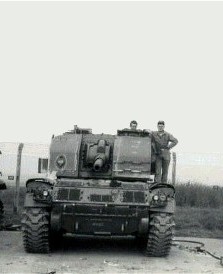
Along in here somewhere we started getting a certain
type counter reset mechanism into the shop which had
broken gear train, tiny gears. This mechanism was
nothing more than a counter that measured mils elevation
in the 105mm S.P. gun's Fire Control System and had a
"re-set" feature on it. Those things cost around $1,500
apiece and that was in 1962.
I suspected the crew may have done something but didn't
really know for sure and about the 2nd, 3rd one that came in
broken I found that all were broken on the same gun. If
that was the case, then maybe something could be wrong
with the gun that was causing the problem so I asked
them to bring the gun into our shop so that we could
check it closely on our concrete floor.
They brought the thing in and we got into another of
those "darnedest things" but eventually got the thing
working right. I found a manual somewhere that told how
to level the gun trunnions, field method, so we went
right to work on it. I'd never done one before, never
even heard of it but I enlisted the aid of the
Instruments kid Forst so he could get the experience and
we went to work on the thing.
The leveling procedure is lengthy and hard to do. The
M52 gun turret does not rotate 360 deg, only a few, maybe 25 deg right
and left? I've forgotten how many.
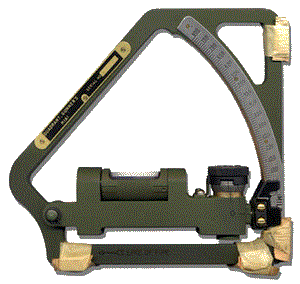 You set the vehicle on 3 jacks (just like one of our
surface plates, you level a flat surface using three
points, not four - 1 on each corner at one end and 1 in
the
middle at the other end). Then you place the quadrant (shown to left) on the breech-block's pads with the quadrant 's axis aligned with axis of the gun tube then adjust the gun to 0
mils on the gunner's quadrant, you level it . You set the vehicle on 3 jacks (just like one of our
surface plates, you level a flat surface using three
points, not four - 1 on each corner at one end and 1 in
the
middle at the other end). Then you place the quadrant (shown to left) on the breech-block's pads with the quadrant 's axis aligned with axis of the gun tube then adjust the gun to 0
mils on the gunner's quadrant, you level it .
Then you rotate the turret as far to the left (or right)
as you can with the quadrant in place. There, level the gunner's
quadrant on the breech-block's pads again and then you rotate the turret all the way in the opposite direction and split the
difference from what you just had, taking out half the
difference with the quadrant and half the difference
with the jack under the hull on that side (the quadrant has bubble like any leveling tool).
Then you rotate the turret in the opposite direction and
do the same thing. You keep doing that until the bubble
on the quadrant reads level throughout the traverse from extreme left to extreme right.
We had a Hell of a time leveling that thing, I think
because we used hydraulic jacks instead of mechanical
ones as they were all we had, but we finally got it
reasonably level then moved to the gun elevation check.
Forst ran the inside and I ran the outside of the gun's
leveling. Forst did a good job on it, too.
Here, with the vehicle and gun trunnions leveled, the
gun is checked to make sure it will elevate throughout
it's operating range which is 1165 mils.
But something was wrong as the gun would only go to
about 1148-50 mils, met resistance, and felt kind of spongy at the end of
travel so apparently when the gun was at extreme
elevation it had some kind of interference between the
Fire Control linkage and the gun system in that last
little bit of movement.
Now, when the arty outfit pulls maintenance on the gun,
part of the drill is to run the gun through it's extreme
elevation - just keep raising it until it stops then
back to level. The elevation counter is connected to
the gun naturally so apparently when things are just
right that little bit of pressure at the end of travel was enough it could
break the counter.
Well, we were running out of time and the arty outfit
wanted their gun back so we had to break off and I said
Hell, let's just put a block on the thing so they can't
elevate it past the 1140 mils and that's what we did. I
had the service department come down and weld a small
block of steel to the turret hull at an appropriate
location so that the gun couldn't elevate past about
1125 - 1140 mils (they only lost about 20, 30 mils at top end).
They got their S.P. gun back and we never heard from them
again so we assume it was repaired. That gun had to come
out of depot that way and I think it was some
federal
facility
in the state of Washington that put the gun
out.
I was kind of proud of what we had done. I don't know
how everybody else felt about it as we had the gun in
the shop almost 3 weeks - but then we did a depot job
with just very minimal tools and equipment, as far as I
was concerned. In my 6 years in Army Ordnance and 1 year
in an arsenal, I know of no one else who even tried to do what Forst
and I did! And far as I'm concerned we were successful!
The arty outfit had 4 guns but as far as I know the other 3 were OK.
By then the instrument shop had filled up with too many
people. Hell we didn't have enough stools for everyone
to sit! I think some of the other sections had more or
less the same problem.
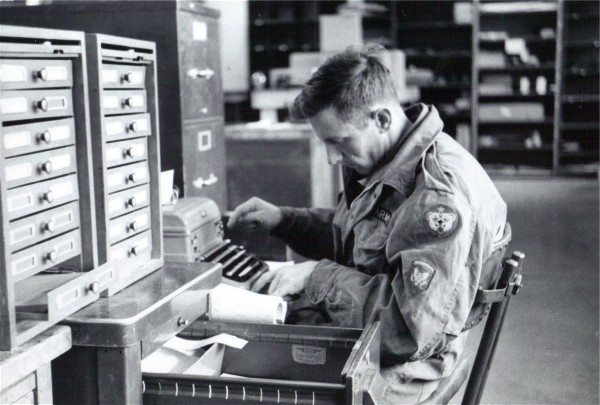 So, I suppose that they realized
that and came up with the idea of cross-training
everybody in the company. Well, if they did everybody,
that would reduce surplus workers
by half. 'Course they never come close to half. So, I suppose that they realized
that and came up with the idea of cross-training
everybody in the company. Well, if they did everybody,
that would reduce surplus workers
by half. 'Course they never come close to half.
But I saw that as an opportunity and realizing the
importance of logistics, asked for and got the supply
cage where all repair parts that were requisitioned in
the company were sent through that section. They only
had one guy in the cage, a SP-5 and he had to do
everything himself so I talked to him and boy, he was
ready for some help, being short-handed anyway.
I went to work in the parts section and he was right, he
was losing control over his parts so we set out to do a
physical inventory, always a heck of a job, and we
finally got the place straightened up. Also, I took
classroom training on the job of "Stock Control Posting
Clerk" which experience helped me with Farmall Co. and
Young Radiator Co. later on in civilian life. The
section leader was a very good parts man and I cannot
for the life of me remember his name. It may have been
Harrison or something like that.
He would gather all the requisitions
generated by the job orders in the shop from the
different sections, get them into some kind of order and
if we had the parts on hand, we issued them right out
otherwise I generally took them over to "tech" supply
and picked the parts up there. Every day I made that
run. If they didn't have them, they got put on order
there.
After that was done in the office, I would pick up from
them previously ordered parts and any that we ordered
just that day get them loaded on the truck and then head
back to the company. I generally drove the 6x truck and
Shultz accompanied me with a 5-ton wrecker to
load/unload parts - there was everything from small
screws to tank engines and gun tubes.
And being in Alaska, one time while I was at Tech Supply (in old wooden building) we had a problem with one requisition
and the section chief, a master sgt, and I were discussing it, me on
one side of table and he on the other and the table full of punched IBM
cards between us. About that time we had a pretty good tremor and the
light on a drop cord started jumping around and dust/dirt started
filtering down from the ceiling and got on some of sarge's cards. Now, I
know God is boss, OK - but sarge stood his ground and when sarge was
done voicing HIS displeasure, I'm sure the Lord heard'm! The tremor
stopped and I left sarge to his contaminated cards, got in my truck and
left.
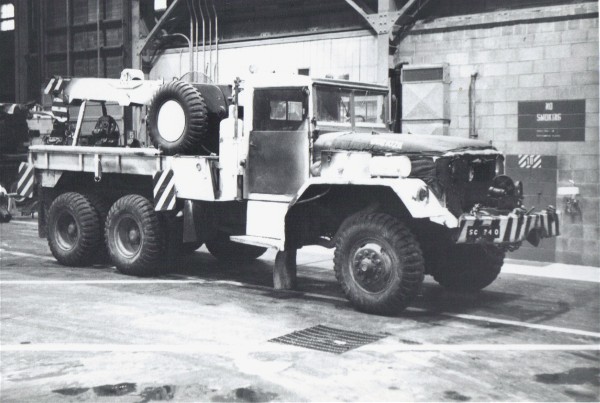
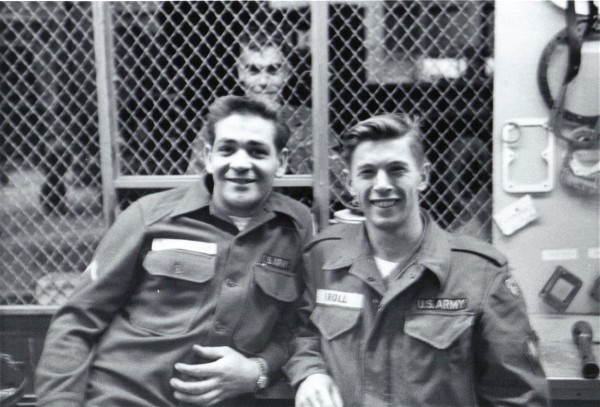 And this is Shultz and Kroll, our wrecker
operators.
And this is Shultz and Kroll, our wrecker
operators.
Here is a picture of some mechanics
at work and though you can barely see it, the parts
cage is just in the background. The small parts are
kept in the cage and the big stuff was outside the
building. And below is a picture that I've kept over
the years because it shows the equipment available in
the shop and you can see that the mechanic is using
the stuff just exactly as he should. It's not only
safer but is actually faster in the long run.
We marched to and from the shop a couple times a
day, from the morning work formation and
back for the noon meal then back to the shop for
remainder of the work day. We had animals roaming the
post and one time a moose cow and her calf wandered
into the barracks area and when we were marching back
to the barracks at end of the day, they came towards
us, got all confused and then panicked and ran right
through our formation. The guys just whooped and
hollered and the animals then took off down the street and we
formed right back up and continued on our way to the
barracks and our evening meal. Everything normal
........ 'bout like making way for any pedestrian you
meet on the street.
I was reading the Anchorage newspaper and they had
article with picture in it about this bull moose out
at the international airport having a confrontation
with this passenger plane. It was during the moose's
rutting season and this bull moose apparently did not
care for the way the airplanes were entering his
domain so when one of them went out to the end of the
runway and was setting there revving their engines,
the bull moose came out of the nearby brush and
attacked it! He rammed the fuselage a couple times,
shook his head then turned around and trotted off
........ they had to hold the flight and bring a crew
out to check the plane for damage before they took
off.
They had another instance up in Ft Greely, a cold
weather test facility the army operated. It was north
of Anchorage and almost all the way up to Fairbanks.
Three of their guys were on their way to the PX and
this bull buffalo took out after them and they took
off for the building and just made it into the
building, then he attacked a car there. I guess he had
attacked a car not long before, too. They called the
MPs and the bull's luck had then run out as they came
down and didn't mess around - shot and killed the
animal right there.
Fortunately no one was hurt in these episodes but
there were injuries, generally in confrontations with
bears.
Man, they had a brown bear mounted in front of the
sporting goods store where I bought my ammo. Lordy, I
hope I never have to meet something like that.........
ANYWHERE! That sucker was standing and was at least 14
ft tall.
One winter we are just laying around there and
decide to go do something, anything to have something
to do. So we decided to go skiing so we went to the
supply room to see if they had any wax and of course
they didn't have downhill but they had climbing wax so
we had to take our skis, unwaxed and see what we could
do with them. We started out through the boonies there
close by and we were going down this tank road, I
reckon it was. Any way it had been leveled out
somewhat on the side of the hill where we were and we
took off down the road.
We are going down the thing as best we can on the skis
and since they are cross-country types they are not
really made to steer, you just run in them. Well
we come to a little grade and start gliding down
around the hill the best we could on the road and we
come up to this kind of sharp little curve where the
road wraps around the hill and one of the guys is
right there about 15-20 yards in front of me. I'm
trying to not wreck and not paying much attention to
him and when I finally negotiate the turn on the hill
I look up and the guy who was in front of me is gone -
nobody there.
I stop and am looking around trying to see where he
went and couldn't see him any where and pretty soon I
can hear this voice calling from far away and I
thought what the world is that and about that time
this tree off over the side of the curve shook a
little and I started back up there and it was a pine
tree of course and completely covered with snow and he
had ran off the road, flew through the air and lit in
the tree UPSIDE DOWN with his head and shoulders in
the deep snow on the ground and the skis caught in the
tree limbs. Well I started working on him to make sure
he could breathe and another guy got there and helped
me and we were all laughing like crazy and we finally
got him out of there.
We were lucky no one got hurt.
Then we decided to go hunting for Caribou. Well, took
some planning but we finally got everything lined up
and there were five of us including a 2nd Lt. and we
could take an army 3/4 ton truck for the trip. Well
the caribou migrate out of the arctic and winter in
the Lake Louise area up north of Anchorage a ways and
it's a one day excursion. There is a bag limit of 3
animals per person. I'd never heard of such a thing
but that's what it was.
We head up the road and are there before too long and
when we pulled into the area, we are setting on this
ridge and the boys decided they would drop somebody
off there and they would go on and come back for him
on their way out of the area and I got picked. So they
take off and leave me there.
I can hear firing almost all around me but it's down
lower than me, below my ridge. There is nothing at all
going on where I am but pretty soon this single
caribou comes up and starts to cross the ridge right
there in front of me maybe 70 yards away in fairly
deep snow. When he gets up the hill and almost
directly in front of me, I fired at his head and down
he went but got right back up and went a few steps and
stopped. I was moving quickly towards him and when he
stopped so did I and aimed and fired again, same
result. Down he went and struggled back up kind of
shakey and I fired again and down he went again but
that time he couldn't get completely up he was sitting
on his rump and holding his front up with one leg.
I knew then that something was bad wrong, probably my
gunsights (but I was all excited and out of breath
too). I was using an old WWII 8mm German Mauser which
my brother had been "sporterizing" but still had the
military sights and I had taken with to Alaska before
he was done. So I got as close as I could and reasoned
on a neck shot because of the way he was positioned,
I'd hit something vital so I fired and that time
I put the poor thing out of his misery. I had hit and
broken 3 of his lower legs!
I dragged him by his rack through the snow to the
little road and was waiting for the other guys and
they weren't long getting there. They also each had
one animal and we then went back to the post. They
dressed the animals out and guess what? I had the only
animal that was not gut-shot or just plain shot to
Hell!!
Yes sir! And we donated the meat to the orphanage at
Homer, Alaska. I never hunted after that unless I knew
for sure the capabilities of the weapon I was using.

For some reason, I never
understood why, we suddenly had to start pulling
guard. Here I am clear out in the boonies somewhere,
actually off-post, I think, guarding some WWII
installation of some kind. I had another picture of
the old wooden building which design you would
immediately recognize but I have lost it somewhere.
The guard shack is on the
picture's left.
In Jan/Feb 1962 we went on the 'BIG' maneuver.
The Army started getting ambitious I reckon
'cause it was held farther north than any of the
other ones that I am aware of. They decided to
do it in the Tanana River area along the ALCAN
between Fairbanks and Tok Junction, Alaska. Now
that is one of the coldest areas in the state
proper.
Down in Anchorage the weather is influenced by
the Pacific stream which comes up from Japan and
goes around southern Alaska and back down the
American west coast and on by California, etc.
If you are in this area you can expect some mild
weather in the winter.
BUT ....... if you leave Anchorage and go
across the mountains to the interior of the
continent - buddy ........ beware, that's all I
can say. If you get away from that ocean, it
gets really cold.
And that is what the army did. They set up this
exercise called 'Great Bear" in the area
mentioned above.
What an adventure that was! We started moving up
the roads to get there and we went from
Anchorage to Tok Junction, a village where the
ALCAN comes out of Canada and forks, one road
going back down to Anchorage and the other going
on west to Fairbanks, following the Tanana
River.
When we had got to the Tok Junction area, it was
so cold you could put your hands anywhere on the
truck engine except the manifold. There was
three of us in the cab of the truck and the
personnel heater was going full blast and we
just got colder and colder and soon my feet were
getting really cold. It's getting dark and just
in time, as far as I'm concerned, we arrived at
our area.
The engineers had bulldozed a park area for us
and we pulled in there kind of helter-skelter
and the guys bailed out of the trucks and
without orders immediately started setting up
the 5-man tents. First time I ever saw a bunch
of GIs jump right in and do a job without some
hectoring.
Heh, then the sgts couldn't get them out of the
tents to reorganize and repark the trucks. It
was 65-70 deg below 0. I'm from Iowa and I
thought I'd seen cold weather but never anything
like that.
They got a few of the guys to help with the
trucks as they wanted to restart them every so
often through the night. The next morning the
guys realized that they were there for it so
they got to work, untangled the traffic jam and
set the company up proper, everybody in place.
Immediately, water was a problem. they had water
trailers with heater coils on them but they were
a pain in the ......... but they somehow kept
water in the messhall.
Our section screwed up again. I didn't have
anything to do with it but one of the small arms
guys got his buddy artillery guy to convince our
platoon sgt (who stayed in Ft Rich with a "bad
back") to let them take a "platoon-sized tent"
(like we'd do shop work in) instead of 3-4 of
the 5-man tents and that way they could burn
diesel fuel and use a 50 gallon drum instead of
the 5 gal jerry cans which had to be changed
every few hours. Also, and most importantly, the
larger tent had no liner.
It very nearly lead to a disaster.
We hadn't been there 2-3 days and on a very cold
night the fire went out. It got colder and
colder but no one would get up to investigate.
Finally, one of the guys at the back end of the
tent got down into his completely zipped up
sleeping bags (we each had 2 bags inside a
canvas cover) and did exactly what we had been
warned about ...... losing contact with the
closed opening and started smothering to death.
I heard something sounding like somebody way off
trying to get somebody's attention. I listened
and finally got woke up and figured it had to be
coming from our tent so raised up my head and
was looking around and then distinctly heard it
coming from the far end of the tent to my right
so I unzipped my bag got out in my long johns
and headed to the end of the tent and somebody
turned the light up and somebody else was
already there and was helping the guy get out of
his sleeping bag. He sat on the edge of his cot
breathing in as large quantity air as he could
in huge breaths and finally got to breathing
normally.
I'm not sure anyone would have gotten out of the
sacks if it hadn't been for that guy smothering
but when we were up then we fully dressed and
got everybody else out of their racks and made'm
fully dress until we could get some kind of fire
going in there. We could very easily have just
lain there until we were really in trouble.
The guys who's project it was got right to work
trying to amend their error, I reckon, and went out side
to find the problem and of course the diesel fuel had
frozen in the line at those very low temperatures. They
shook the line to get flow going and the line just broke
in several places because it was so cold. They had a
heck of a time but they finally somehow got some heat
back into the tent.
We kept the tent for some reason but the fuel and the
stoves were redone. And the weather warmed up a little
and we finally got through it. Sometimes just the wind
can do it to you.

We had a thermometer hanging on a tent rope just
outside the tent and it generally read in the -50 to -60
degree range and we thought it might be colder than that
so we took it off the tent rope there by the tent and
put it on a tree about 25-30 feet from the tent and sure
enough, we recorded 72 deg below there next morning.
I never took my camera into the field but dearly wish I
had now.
I got tired of laying around the tent so I asked for a
job and they put me to driving for the mess hall. I got
to visit a building somewhere up there and they said
belonged to an oil company and they had made it
available to the army so Ordnance could work on the
vehicles inside in warm air. Just a repair shop probably
1/5th the size of our regular shop.
Another thing kind of interesting ....... while driving
the truck, I had to haul hard-frozen fresh fruit and
vegetables to the dump a few times. I'm not sure about
it but I think they were frozen before they got to our
company. There for awhile it was bitterly cold and the
messhall really struggled to get us some "balanced"
meals. Canned stuff would be frozen solid, too if
everyone did not do their jobs. They deliberately let
the fresh milk freeze to preserve it and brought it
inside the mess tent to thaw and use as needed. But the
stuff separated when thawed and there was about 1/4 to
1/3 of the carton's contents turned to powder with some milk stuff
on top.
During this really cold weather, we ate a lot of pasta
and powdered stuff with water. Things people take for
granted down here in states just was not the case up
there.
And I got to haul some JP4 jet fuel for the Canadian
army. Their Princess Patricia's Light Infantry was in
the maneuver with us and they needed some fuel for their
Caribou Airplanes so I hauled 5-6 drums to them. I was
scared of the stuff because I was told it was "Jet Fuel"
- heck I didn't know it was just kerosene until one of
the Canadians told me (they were a Canadian Airborne
unit).
Interesting airplane, that Caribou. It had a tail
section that just went up in the air - too far, it
looked like and I couldn't figure what the deal was
until I saw one take off. They were turbo-prop, I think,
and used a very short runway. When the plane took off
they just sat it back on it's tail (or where the tail
would be on regular aircraft) had the nose right up in
the air and it was airborne in nothing flat. Very short
runway for that size airplane.
We hung right in there and tried to do our work there
but sometimes it was downright difficult. One time the
track mechanics were working on an M8 tractor and the
engine caught on fire so they grabbed the fire
extinguisher they had and got a couple small squirts out
of it and somebody came running from the mess hall with
another one and it was the same thing, couple little
squirts and that was it. Nothing they could do but watch
the fire burn out.
There is an awful lot of stress on the mechanics and the
engineers in a deal like that. I felt sorry for those
engineers. They had a hell of a job.
Whenever I saw infantry or one of the line outfits they
always seemed clean and spruced up but you could
generally tell an engineer or an ordnance wheel/track
mechanic. They were often dirty, many times unshaven and
their jackets and parkas were generally dirty as hell,
even had tears in them. With all those clothes on they
looked like some bear waddling upright down the road.
Many times during maneuvers the mechanics had almost had
no time to even eat. One time when I was in Germany and
helping to change out some tank gun tubes, we were
billeted right next to the guns and our meals were
brought to us to save time.
Towards the end there we made a move that took us to the
other side of the Tanana river. We moved down this road
the engineers had cut and we drove up to the river and
there was this big mound like the access to a bridge and
we started up it with me driving the Instrument ordnance
van - a GMC with an automatic transmission - and one of
those guys I just described above flagged me and came up
by the cab and said "All passengers dismount and walk
across the ice. Driver, put it in low-granny, open your
door and step onto the running board - one foot on the
running board and the other on the accelerator and do
not let it shift gears." And I went on over the hump
which was a pile of tree limbs spread over the ice and
snow and water onto that, freezing and holding
everything together ..... an ice bridge!
Here I am again, thinking what in the world ....... And
when I was on the ice proper it would let out a big crack and
it'd just take off down the river and you could hear it
fade away. We got across OK and turned around and came
back just a few hours later. I don't know what the deal
was.
I have since seen on TV the guys driving their trucks on
the frozen lakes up in Canada and I have an idea of what
those guys are facing.

We got a P.C. froze to the ground and they were trying
to get it loose and they burned around the tracks, they
rammed it with another vehicle. Finally they had it
running and they would accelerate the engine then pop
the clutch so to speak and finally they decided to do it
all at once so they got everything ready, revved the
engine way up, gave the signal and the driver threw it
into gear and the other P.C. rammed it all at the same
time and just tore the "spokes" out of the drive wheels,
broke like glass. And it stayed stuck to the ground.
The weather was particularly hard on things rubber. We
were running low on inner tubes for the tires and the
flexible brake lines for the front wheels of trucks was
getting hard to find. Tires had big chunks of rubber
torn from them because when you drove the tire heated up
a little and when you parked it melted the snow/ice and
settled a little then froze tight. When you took off
chunks of rubber might stay in the ice behind you.
It was just really hard to do any meaningful thing there
- too much time was spent just getting by. In order for
a mechanic to work on something it has to be enshrouded
some way and heat pumped into it so the thing can warm
up a little bit before you even start to turn a nut
........ if you don't warm it up some there is a good
chance a steel bolt will just snap off at the
temperatures we were experiencing.
That aside from the fact the mechanics would suffer
frostbite if they gripped a tool or a workpiece.
They had thin little gloves they wore when working to
help protect their fingers and hands against frostbite.
I wasn't even an automotive mechanic and got a dose of
that ..........
Later on back at post, I had a pretty bad cut to my hand
working on something there in the instrument section and
we had no first aid kit so I went to the shop office and
they had one but when we opened it up it was empty. So
we are trying to get it to stop bleeding and this guy
who was from Armament Platoon came in to see how I was
doing and he said he had a kit in the trunk of his car
so he went out to the parking lot and got it.
'Course, he has his parka and stuff on when he goes
out and he brought the steel kit in and laid it on the
counter and I grabbed onto it and tried to open it and
suddenly it just felt like bees stinging my fingertips
and I got turned loose of the thing and had white frozen
spots on my fingertips! I got frost-bit handling a
first-aid kit, for cryin out loud! And it took several
minutes to get rid of that.
There are lots of ways to get hurt in the army ........
The exercise wound down and the weather got some better,
up to -40 maybe and I got a chance to stop at this truck
stop there east of Fairbanks a ways and I think I went
there a couple times and even got to talk to the guy who
owned it. 'Course the place is full of GIs but he was a
friendly man, sensible, and he said he had come to
Alaska 2-3 years before and set the truck stop up. He
wanted to get away from the USA and some of that stuff
then he waved his hand around and said "Now look, here
they all are!" He had 2-3 teen daughters and I could
understand why he might be worried.
Soon after that we wrapped it up and we were back in Ft
Richardson. When we got back, the Army issued a little
card, like a business card that said something about
having the Great Bear maneuver in -55 deg weather and
the guys, all over the post, sent their cards in because
they didn't say -65 deg so they re-issued the cards with
a more truthful representation of the factual temp. I
can't find the thing anywhere now.
It was one big adventure, Ill say that.
One thing for sure I learned up there ...... who to go
see to get a heater fixed. Now I am talking about the
various heating systems in the vehicles - they had all
kinds. All the trucks were winterized and that meant
engine heaters, battery heaters, personnel heaters,
space heaters for the mechanics out in the boonies, etc.
When you wanted to start a truck up there in the winter,
it was a regular ritual. First, before you even turned
the ignition on, you started the engine heater. It was a
gasoline heater, I think, and heated the oil pan and the
batteries on most GM models. After that had ran so many
minutes, you turned the ignition on and tried the
engine. I can't remember exactly but you had to watch
the defrosters for the windshields. If you got a sudden
rush of hot air onto a cold windshield they would crack
across the bottom. Best thing was to warm up the
windshield, engine and personnel heater all at the same
time. if you did every thing right, the oil will be
warmed and allow the engine to turn and the batteries
will be somewhat warmed and closer to full power and all
of that stuff.
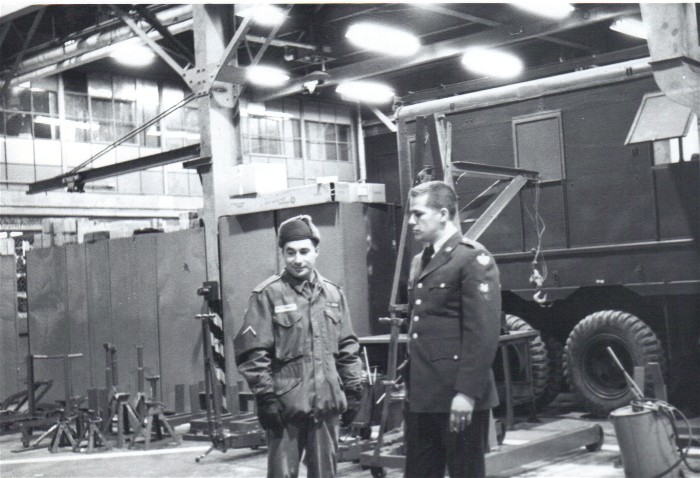
The heater business was good business up there and
here is the man to see - one of the best heater men up
there - the guy on the right, Specialist Downey. Wasn't
too bad on Carburetor and Ignition either, if I remember
right.
We had a battery of the Twin 40mm
AA guns up there - same type as the ones we had in
Germany. They brought them in for a checkup and no
one had been around them so I got the job,
naturally.
I grabbed my tool box and went out into the park by
the shop where they were and started checking them.
I leveled the guns off on the first one and checked
with the gunner's quadrant and the darned thing was
about 13 mils minus so I adjusted the mechanism and
went to the next one. They looked like they never
got used - looked pretty good. The second gun
checked out about the same and I thought that's odd.
And when I was done with that one I went to the
third gun and it checked out the same and then I
knew I was in trouble, they couldn't ALL three be
the same, just no way so I went into the shop and
finally found a manual for the thing and sure enough
..........
They had to have 13 mils super-elevation set in the
system. Kind of like the "battle sights" on the M1
rifle. I think that was 3-4 clicks elevation.
While we are on the subject, the F.C. Instruments,
when attached to linkages in tanks, artillery, the
AAA gun, etc, have Ordnance Seals put on them where
the adjustment is made. It can't be changed unless
the seal is removed. The seal was a little braided
wire with a flat lead pellet attached to one end.
The pellet had an opening in it that the plain end
of the wire could be passed through special small
holes in the linkage and then back through the
pellet and a plier-like sealing tool with the
Ordnance Emblem on it squeezed it onto the wire.
After system repair was done, we would put the seal
on it. I packed the sealer in my tool box. I didn't
use it much in Alaska but did while I was in
Germany.
Anyway, I put them all back to the setting in the
manual, re-sealed the linkages and was glad I had
decided to check the deal out. Don't ask me why I
didn't check the manual in the first place. Manuals
were hard to find around there for some reason and
anyway, I thought I remembered how to do it
from my time in Germany but I had forgot about the
super-elevation.
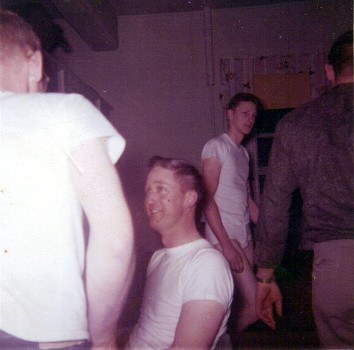 Along in here a Sgt heard about our section and
looked me up and asked me if I could fix a pair of
binoculars for him. Well, I did do some of that for
friends or people I knew and generally did it free
gratis but this fellow I didn't know and kind of
took a dislike to him right away but I told him I
would take a look at them - maybe I could. He asked
what I wanted for pay and I told him a fifth of
vodka. I didn't drink the stuff but some of the
other guys did.
Along in here a Sgt heard about our section and
looked me up and asked me if I could fix a pair of
binoculars for him. Well, I did do some of that for
friends or people I knew and generally did it free
gratis but this fellow I didn't know and kind of
took a dislike to him right away but I told him I
would take a look at them - maybe I could. He asked
what I wanted for pay and I told him a fifth of
vodka. I didn't drink the stuff but some of the
other guys did.
Well he brought the glasses over and I looked at
them and they were some kind of foreign made opera
glasses. I didn't want to mess with them and one
telescope has a chipped prism and it cut the light
quite a bit so trying to get out of it I told him I
couldn't get parts and so forth but he insisted I
just go ahead so I told him they'd be ready next PM.
He could pick them up then. So we went our ways and
I opened them up and cleaned up the lenses which
some were chipped, from dropping I imagine, and it
helped them a little.
Well, the next day I had to go to dentist and they
drilled between two front teeth, filled the hole
(hell of a deal) and I got back to the barracks in
plenty of time for the sgt to pick up the glasses.
He came around and gave me a paper bag with the
fifth in it and I gave him the binoculars and away
he went. Never seen him again.
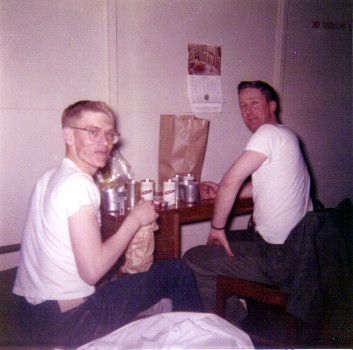 However: I opened the bag and it was Starvsky
Vodka. I'd never heard of it, didn't know that much
about it, so anyway I took it back to the barracks
and some of the guys tried it but they didn't seem
crazy about it so Forst and I figured we may as well
drink some of it and throw the rest away.
However: I opened the bag and it was Starvsky
Vodka. I'd never heard of it, didn't know that much
about it, so anyway I took it back to the barracks
and some of the guys tried it but they didn't seem
crazy about it so Forst and I figured we may as well
drink some of it and throw the rest away.
And that's what we did and do
you know that stuff dissolved the filling in my
just-filled teeth and it came out and had to do
it all over!
That Alaska is such a hugely grand place - big
etc. It seemed that you could find anything there.
It was really strange. The PX was filled with
clothing from Austria, merchandise from all over
northern Europe. I bought ammunition for my 8mm
German Mauser rifle in Anchorage, no problem at all
- made in Norway.
I just couldn't figure it out and one day a worldly
sgt (our army gets around pretty good, all over the
world) explained it to me. He said well, the market
here is not that big and it cost a fortune to ship
stuff up here from CONUS so it makes the Europeans
and Japanese competitive. They can fly over north
pole area to Alaska almost as easy as CONUS can fly from 'lower 48.'
Well, not sure how that plays but they sure had an
international flavor there in Alaska.
We were getting closer to rotation and one of the
good guys was leaving, a guy from Texas, and he came
into the bay and asked if anyone was interested in
going downtown for a Mexican meal. No one said
anything and he looked at me and asked if I was
interested, he was buying and I told him that I
didn't know anything about Mexican food and he said
I'll take care of that, it's not that big a deal
anyway.
Well, I got curious having heard of Mexican food and
all but never eating it so I said I'd try it. Glad I
did.
We went to the Mexican restaurant there in Anchorage
and he explained all to me and we ordered and I
stayed away from the hot stuff and we had a white
table cloth and when they brought the food it was
all reds and greens etc and when it was set on the
table, I thought it was about good looking meal as
I'd seen and it was very good. Really enjoyed it.
It seemed like they were barren up there and at the
same time they had EVERYTHING.
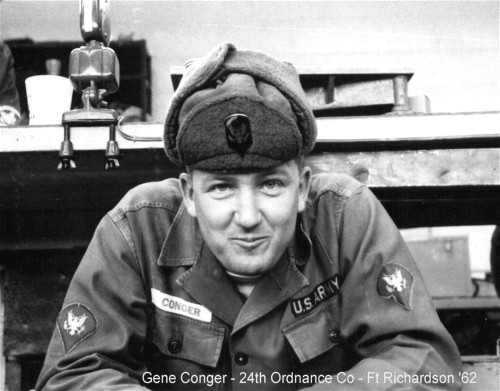 One day, they came to me there in the bay and
said you have a phone call. I didn't know anyone
locally so I thought there was problem at home and
went to phone and this woman was on the line and she
started talking to me and pretty soon she says, "You
don't know who this is do you?" and I said no and it
was my aunt Lavaughn, ex-aunt, and she and her new
Chiropractor type husband had moved to Alaska. So,
they came picked me up and we had good visit.
One day, they came to me there in the bay and
said you have a phone call. I didn't know anyone
locally so I thought there was problem at home and
went to phone and this woman was on the line and she
started talking to me and pretty soon she says, "You
don't know who this is do you?" and I said no and it
was my aunt Lavaughn, ex-aunt, and she and her new
Chiropractor type husband had moved to Alaska. So,
they came picked me up and we had good visit.
One day in the shop it is kind of busy and Forst
went to take care of someone who walked into our
shop. I never looked up or anything told Forst to
get it so he went over to the counter and I kept
working on whatever ..... and Forst comes back and
says a supply sgt. has got a whole bunch of
observation telescopes and he wants to turn them in
for checks/repair. I didn't even look up I just said
"He knows they can't turn everything in, tell'm to
leave some and we'll get the rest later.
Forst went back and then he came right back to me
and said "He said for you to get your butt over
there and take care of it." So I whirled around
ready to do battle and there stands Howard Hudson
from my little hometown in Iowa!!! He'd recognized
me when he came in and was tormenting me. Turned out
he was the supply Sgt for the Alaskan large bore
rifle team and they were getting ready to go to
Indiana for the Army matches and he had a bunch of
the 20x "Observation" telescopes that the shooters
use and he just wanted them checked, etc. Since he
was not a combat unit, I was sure was OK.
Another time, I was walking down the street and here
comes this car just right there by the walk and I
got a real good look at the occupants and would you
believe? My typing teacher from High School?
Yep and her hubby was driving the car. She was
teaching at my school and she and a senior student
became enamored of one another and she became
pregnant so they got married and I hadn't seen
either of them since. I assume she was
teaching in the area there at Ft Richardson.
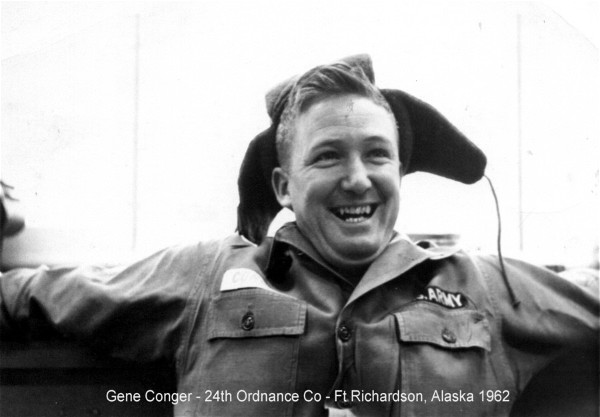 Along about this time another 3rd A.D. guy
showed up. One of the guys, Dietrich Woehler, one of
the German GIs of Company B. Apparently, he was
still trying to get his citizenship thru Army
service. He was a wheel mechanic and I was not
especially close to him, didn't know him that well.
I knew he was a good soldier though. I just got to
talk to him one time and I thought he said he was
going to be the shop officer as a Warrant officer. I
think I got it right. Never saw him again, as I
rotated out.
Along about this time another 3rd A.D. guy
showed up. One of the guys, Dietrich Woehler, one of
the German GIs of Company B. Apparently, he was
still trying to get his citizenship thru Army
service. He was a wheel mechanic and I was not
especially close to him, didn't know him that well.
I knew he was a good soldier though. I just got to
talk to him one time and I thought he said he was
going to be the shop officer as a Warrant officer. I
think I got it right. Never saw him again, as I
rotated out.
I'd already seen my old 1st SGT there. And Hudson
told me that Boliver Large was there too. He was
from our hometown also.
In my 3 years in the 3rd AD I met almost no one I
knew before I went into the Army, except the 2 guys
at Knox.
But in Alaska .....? Of all places.
And speaking of rifle teams, along about
this time, I joined our Company's Small Bore Rifle
Team, trying to find a way to kill some of the
time in Alaska. I had never fired in matches before
but it turned out to be quite an experience and I
enjoyed it very much.
We used the .22 cal. bolt action "match" rifles.
They were pretty good rifles and we had some of the
gear to go along with them, like firing jackets,
etc. They had "Peep-Sights", slings and so forth.
They had the heavy barrels and you could just feel a
slight recoil when you fired them. They were nice
rifles. I can't remember how many people were on the
team ........ seems like maybe a half-dozen and a
couple extras.
I can't remember for sure but I think we fired at
targets 25 feet away (the bull was exact diameter of
the .22 bullet). There were possible 400 points
where firing was done from 4 body positions. So each
position yielded up 100 points. There was a sheet of
10 targets each having 10 points to make the 100
total. So 4 sheets of 10 equal the 400. Interesting
in that each individual target only had 5 rings. The
bull was 10 points, the next ring out, the 9 ring,
was 9. Then the 8 ring was 8, then the 7, then 6.
Any hits outside the 6 ring was a 0 for that target,
if you hit outside the 6 ring you "dropped" all 10
points. Each small target received one shot.
When we first started firing, I noticed that most of
the guys concentrated and tried so hard to get
perfect, or near-perfect scores, in the prone and
sitting positions that they were stressed too far
when they got to the kneeling and standing positions
where aiming is much more difficult and they would
miss outside the 6th ring and drop all 10 points,
generally too many times and would turn in low
scores - 325 to 350 range.
So, I learned to relax in the first 2 positions and
to take a slightly lower score than the other guys
and then be careful on the last 2 positions and not
hit outside the 6 ring to keep from dropping the
entire 10 points. It worked real well. Didn't
actually make me a better shot but made me much
better competitor and I did very well and really
enjoyed myself. I'd yield maybe 5-6 points in early
part of the match to pick up 10-30 points later.
Also, you may not believe it but smoking just before
you shoot would affect your score. When I was told
that by the team leader, I did not believe it so
kind of checked myself and by golly, he was right.
He had said that if we smoked a cigarette just
before we shot we'd probably "drop" 10-15 points
from our match score. Well, I tried not smoking and
there did seem to be a difference so I would not
smoke just prior to or during shooting and raised my
score another 10 points or so. One reason for this
was the use of the slings during firing. The shooters would strap
themselves into the slings pretty tight (that is the purpose of the
sling - to control involuntary movement during shooting) and the
increased pulse rates from smoking would move the rifle around some. I
don't think the slings and smoking were compatible.
And I just have to tell about shooting when I was a kid growing up.
Everyone around my hometown had guns, generally shotguns and many had
small cal. rifles too (it was illegal to shoot large caliber rifles in
open land of Iowa). Of course, the outhouse became the impact area for
shooting. Whenever anyone had a new rifle, etc they partially drove a
tenpenny nail into the sideboard of the outhouse and shot at the nail's
head. The nail was not driven all the way in, just enough to make it
solid target.
The object was to aim at the nail's head and when you hit it, drive it
farther into the board. When it was driven all the way in, another would
be started if there were multiple shooters. Shooting was off-hand but
not far away. Seems to me like there was lot of bent nails and those
shooters were thoroughly ridiculed.
But to top the whole shooting thing off ...... One day I was visiting my
grandparents on their farm where I hunted every chance I got. I had the
'pump .22 rifle' and was shooting clothespins off a barbed wire fence
and my grandfather came by with some 'milk buckets' from chores and
asked what all the shooting was about and when I told him, he put down
the buckets and sat beside me and asked if he could try it so I said
wait and I'll set the pins up but he said no he'd shoot something else.
So he took the rifle and started aiming and I could see he was shooting
in direction of the fencepost right by the pins. He shot and said 'my
eyes aren't as good as they used to be, would you see where the bullet
hit?' So I went just the few feet to the post and saw the bullet had
just barely missed under the twisted wire where it was nailed to the
split post and told him where he'd hit so he had me come back by him and
he took careful aim and shot again then said to check that shot and I
did and I told him 'You hit the wire!' and he asked where so I told him
'right in the middle - you spread the wires ......' and he got up and
said, 'That's what I was trying to do.' took his buckets and went on to
the house ......... and I never target shot there after that! I've often
wondered how him and my great-grandfather, who was also an excellent
shooter with rifle or revolver, would do in the small bore matches. I
bet they'd win if everything was off-hand or kneeling.
I went fishing down at Port Seward while I was
there. The army had a little deal set up down there
and the company gave me 5 days R & R for some
reason and send me down there. It wasn't much to
look at but it was one of the best real vacations I
ever had in my entire life. They had a mess hall
which started serving early in the morning, 6:00 am
I think, and did not close until 11:00pm and they
had very good food. The terrain was beautiful and
the fishing was great. The boats (with the operator)
costs only $2 a 2hr period (I think). It was just
great. One time a couple whales came by the boat
where we were fishing. Man, those suckers are big!
It was summer time naturally and there is ice
covered hills all round down there mostly on the
south side of the sound. There is a peninsula that
juts into the ocean and its hills are covered with
the ice. Now in the summer the snow has melted and
mostly gone but the ice is still there. Since the
glaciers are kind of south of the fishing area, when
you look at them the sun is actually behind them
with some of the light penetrating the ice and
coming through. It is very beautiful if you get just
the right angle on the ice.
Another plus for Alaska!
I remember telling my buddy and the boat operator
that Elizabeth Taylor NEVER had a diamond as
beautiful as that.
I got my rank back, SP-4 and in no time I got
pro-pay for my Fire Control Instrument Repair M.O.S.
and the extra $45 per month came in pretty handy
there as the cost of living was/is very high there.
I kept working and then another of those things
occurred .........
 Like I said, the missile units converged on
Anchorage and had a firing exercise once every year.
Well, 1962 and they assembled and we got ready to
watch and Instrument Section made all the telescopes
we had in the shop available to the guys so they
could watch, as usual. Come Monday and the guys were
all set up and ready to go ...........
Like I said, the missile units converged on
Anchorage and had a firing exercise once every year.
Well, 1962 and they assembled and we got ready to
watch and Instrument Section made all the telescopes
we had in the shop available to the guys so they
could watch, as usual. Come Monday and the guys were
all set up and ready to go ...........
And they fired the first missile
and it went up, as usual, then laid over on it's
side .......... and blew up!
We were looking for it to take off down-range and
then explode like they had done the year before.
Next day, they fired another one ...... same thing,
just laid over on it's side and blew up!
Then they called the "Shoot" off, and from what we
could get from the guys in our barracks (very
little, actually) they had sent for a team from
"White Sands" N.M. and they were on the way up
there.
They were on the job either that Wednesday or
Thursday, can't remember for sure. Anyway, when they
got there, they fired another one and it did the
same thing and then they shut the Shoot down.
Come next Monday they are ready to try again and
fired one and it worked just like it was supposed
to.
The only thing we could find out was that sometime
during the fall of 1961 they had received a M.W.O.
(Modification Work Order) from White Sands for the
Nikes. Apparently, the MWO was either flat-out wrong
or it was misapplied.
Try as we might, we could not find out. BUT
......... Between the time the MWO was done on the
missiles until the "Shoot" took place, there was no
anti-aircraft missile defense in Alaska, certainly
not at Anchorage.
Couple of things here:
1) The system was undoubtedly complex and mistakes
probably occurred frequently and shouldn't
necessarily be held against the people doing the
work.
2) that was during the height of the cold war and
you cannot rule out sabotage. It would be a very
easy matter to fix up, or alter a directive
affecting the missile's capabilities and I never
ruled that out.
When I was in Alaska, we had the Cuban Missile
crisis and when the president make his public
speech, all the guys cheered- I don't remember
anyone objecting about his actions. So, we had
Hungary when I was in Germany and Cuba when I was in
Alaska.
I was thinking about making a career of the army
about then so I decided to start studying up on the
Russians. I bought some language records at the PX.
Got Russian and Modern Hebrew and the guys asked me
why I got them (in those days it was generally
French or Spanish) and I told them 'cause ...... one
of those peoples is going to wind up running the
world and whichever, I want to be able to speak
their language.
So, I signed up for a class on Russia. I'd forgotten
they had once ruled over Alaska and due to that, the
Orthodox Religion which was big in Alaska, and the
climatic weather being similar to Russia's, there
were people of Russian extraction living there and
one of them, an older fellow who had been a colonel
in the White Army during the Bolshevik Revolution in
Russia, taught Russian history with the University
Of Alaska. So they set it up for him to teach there
at Ft Richardson and I signed up for the class,
finished it and got credit with the University of
Alaska.
I met some, not many, people there in Alaska who
claimed they were related to the original Russians.
Then, one of the guys who was married and had his
family with him took his discharge there and went to
work on the Salmon Boats which were very active and
a guy could supposedly make a good living working on
the boats so Jordan tried it. Not sure how he made
out and he came around once, then I never saw him
again.
I do know that there was fierce competition between
the boats and so forth. Then the competition between
the Russians and Americans got really serious as the
boats had a shoot out and the Americans shot a
Russian crewman ........ then took him to the
hospital at Anchorage!
He got patched up then the Russians picked him up
and took him home.
We got a lot of map reading there and it was just as
strange as Alaska itself. We had several classes
right in the barracks, in the mess hall. About the
only thing I remember was the fact that the magnetic
declination there in Alaska was atrocious. Seems to
me it was up to 40 degrees. Now "declination" is the
difference between True North (map north) and
magnetic north (a magnetic field south of the real
north pole).
If I remember right, the line designating "0"
declination happens to run south down through Canada
and into USA somewhere around Detroit then on into
Indiana and on south. So if you are on that
north-south line and use a compass, true north and
magnetic north are one and the same. However; if you
move east or west there is a variation and that is
called "declination."
Where we were was west about 5 time zones from the
"magnetic pole" and even worse, back towards the
north, there is a pretty good declination and the
farther north you move around there, the worse it
gets and makes big changes pretty quick. In some
places up north the exactness of the magnetic
field's location becomes a crap shoot and is one
reason Alaska's "Bush Pilots" are famous the world
over for flying only with "dead reckoning" most of
the time not relying on magnetic instruments.
Now, thank the lord, we have Global Positioning
System equipment.
Alaska is wonderful and at the same time it can be
very dangerous.
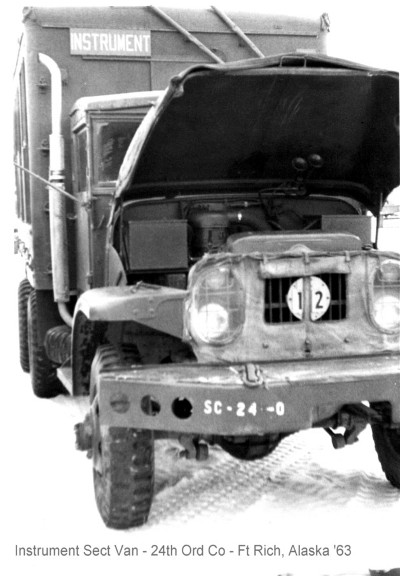
What happened was that in the old Army, what we
called the "Old Brown Shoe Army", career personnel
could often "buy" their assignments through the
personnel system. So, some guy would get plum duty
somewhere and then at re-enlistments just stay there
his whole career until he retired. He didn't go to
war, he didn't have to go to deserts or jungles, he
just sat in the gravy. In the Navy, they called
these guys "Plankers" (I think it was), they stayed
on one ship or in one base, never having to pull
maybe some distasteful duty somewhere else.
Also, there was a time when rank stayed in the unit.
If someone transferred out, he had to leave his
stripes there in the unit. So you can understand a
soldier's reluctance to leave a unit. Now that's
what I heard, I not sure about it.
This was causing some problems in the Military as
the totality of a force was not mixed. You may have
an excellent unit here, but over there is a very low
performing unit and it can't seem to improve. Is it
getting all of the scrubs and the better unit
getting the choice personnel or what? They had to
try and even things out. And guys would hunker down
in one assignment and stagnate, never grow.
So what they did via McNamara, was to ensure ALL
career military men were thrown into the
"replacement" system when they re-enlisted. All the
"plankers" got reassigned when their enlistments
were up and same in the Army. When your enlistment
was up, you could figure on moving. As far as I'm
concerned it was a good thing and should have been
done long ago. Unit history and tradition are fine
to have but let's be reasonable here.
So we got Gibson. Now, I suppose he was all right
but he had let the modern army pass him by and had a
hard time adjusting. He was a 1st sgt and had spent
his 18 year career in Ft Benning and was almost
ready to retire. He came into our company thinking
he was in a Basic Training outfit and didn't
understand that most of our men were fairly mature
militarily, were not recruits to be screamed at and
he absolutely did not like "Specialists" who were
generally the technical people and that the army had
a healthy investment in the training of these people
and wanted to keep them if they could.
One time when I had night duty (CQ), I walked
through the doors of our bay into the hallway headed
towards the latrine to freshen up before the duty
and just as I reached the latrine door there was
this screaming came from our orderly room down the
hallway a few feet and I thought what the Hell is
going on here? And this saucer hat came flying out
of the orderly room door and hit the wall of the
hallway and bounced back and down on the floor
wobbling around to upright and there was this big
gold eagle looking at me ..... AN OFFICER'S HAT!!
And right after it came this 2nd Lt. with his
overcoat on but unbuttoned and picked it up and went
into the Company Commander's Office. I went on into
the latrine and did my thing then reported to the
orderly room for my Charge of Quarters duty
(C.Q.). Sgt Gibson was not in there when I
reported and I asked the clerk what was going on and
he told me that the officer, a new 2nd Lt., had just
got there and was reporting to the company and came
into the orderly room with his overcoat unbuttoned
and had taken his hat off and laid it down on
Gibson's desk and it covered the corner of some
papers Gibson was working on and he exploded and
jumped up, yelling at the Lt "that that was no way
to report" and grabbed his hat and threw it out of
the orderly room's door and told him to report
again. Of course, he did not but retrieved his hat
and went into the C.O.'s office.
Well, there are pros and cons here. Obviously a poor
performance by the Lt. but let's get real here. You
just don't treat officers that way. Nothing wrong
with correcting the guy and even speaking to the
C.O. about it but deliberately try to degrade the
guy with everyone able to see it? Noooo ........
that just does not fly.
Gibson obviously was not smart enough to realize the
Lt. would assume responsibilities in his company and
that Gibson would be rated by the company's
performance and here he had diminished the stature
of someone he has to rely on to get his job done?
It's kind of like shooting yourself in the foot. If
Lt. has no stature how can he command Gibson's
soldiers? But that was the way Gibson had done it
for years.
I got along with everybody there except one guy in
the Armament Platoon and was on friendly terms with
everybody in the place as far as I know.
And during an I.G.
inspection, I went to see the I.G. Now, we had a
bad situation in the shop, especially where I
was, and way too many men sitting around with
nothing to do. At the time we had about 5-6 guys
in the section and work for a couple, maybe. We
talked about it in the shop and no one wanted to
step forward so I said well, my tour here is
over in a month plus days so it looks like I am
the "shortest" man (least time to go) here so
I'll do it so I went to the I.G. and made the
complaint. He was a major and I'm pretty sure he
understood the problem. I had discussed the
problem verbally with the involved Officers and
NCOs of the company but had never made a formal
complaint to them. They would just say there was
nothing they could do about it.
However; in Gibson's scheme of things you never,
never, never complain to the I.G. so I was a marked
man and everyone knew it. That's the reason no one
else would do the job in the first place. Now, if
the Gibsons of the army were right, why was the
"office" of I.G. created in the first place? Yeah,
tell me about it.
Now, my complaint had absolutely nothing to do with
1st sgt Gibson, he was never a player in any of that
stuff but he took it personal and corralled me and
threatened me with courts martial and every thing
imaginable. In his old army that was the way things
were done, everything was on a name basis and you
protected all your contacts even above the interests
of the Army. Well, he pissed me off and I told him
no way was he going to court-martial me and he let
me know right now what a piece of crap I was and
that he could break me for "Inefficiency" any time
he wanted to and I told him to have at it - I didn't
see how he could do that because I was tested every
year in my job and had a high score, was school
trained and 5 years experience and was drawing
Pro-Pay 1, etc. I said you'll have a heck of a time
proving "inefficiency" - I wasn't necessarily the
Army's model soldier but I had a very good record
and I knew it. He just started frothing at the
mouth, literally, and walked off.
Next thing I know, here comes Pergerolies (?
spelling) our shop sgt. boss, who had already filled
in his portion of my unit rating and told me that
Gibson had asked him to withdraw his good, favorable
rating and re-do it so as to show it unfavorable.
Pergerolies said he wouldn't do it so I told him to
go ahead - do whatever he thought he had to do to
protect himself, that I would understand and bear no
grudges. I had always liked the little Greek guy and
we got along good. I never knew for sure but I think
he stood by his first evaluation.
Nothing happened so I proceeded with the rotation
paperwork and the personnel clerk asked if I had a
preference for the outfit I'd be sent to and I asked
if any new outfits (modern equipment that requires
new tactics, etc) were out there and he checked and
said yes, we have re-organizations of the 5th
Infantry Division which is going Mechanized and the
11th Air Assault Division and he said the Air
Assault outfit was like airborne only would be a
heavier hitter than older Air Borne units. So I
selected the 11th Air Assault.
See the difference between Gibson and me? The
previous paragraph should explain it all. His type
dodged the responsibility for staying up to date and
I'm trying to give my country the best service I
know how. Here the American Army has finally adopted
the concepts of air cavalry and Germany's mechanized
infantry divisions 15 years after WWII and Gibson
wants to stay in Benning and keep kissing butt?
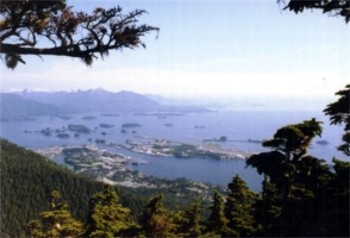 Well, came time to get the final orders so I went
to personnel to bring everything up to date and the
clerk, same one, tells me "Well, the 11th Air
Assault deal fell through but the 5th Mechanized
Infantry is still going .......... and I said, "I'll
take it!"
Well, came time to get the final orders so I went
to personnel to bring everything up to date and the
clerk, same one, tells me "Well, the 11th Air
Assault deal fell through but the 5th Mechanized
Infantry is still going .......... and I said, "I'll
take it!"
And that was it, I was out of there within a week
headed for Ft Carson, CO.
Got down there and it was like Alaska, in a way.
Jeez, the 5th Infantry's army ways were just as
exciting an adventure as Alaska was - not the army
in Alaska but Alaska itself.
And Gibson got my pro-pay. He rated me so low as a
human being on his part of the evaluation that it
dragged my score down enough I was under the cut-off
points for the pro-pay. It didn't hurt me at all,
certainly never came close to getting one of my
"stripes" but he did get the bonus pay. All for
going to the I.G. about something that every officer
on the post should have been raising hell about.
BUT ....... according to the Lineage Chart at the
top of this page, the 24th Ordnance Co was
de-activated in July 1964 - about a year and a half
after I went in to see the I.G. so what do you think
of that now, Top?
Goodbye Alaska, you beautiful, dangerous,
big, hostile, friendly, WONDERFUL
place!
Ernest E Conger 6/14/2013
This webpage made with SeaMonkey
Questions or comments may be made to EE Conger
here.
|